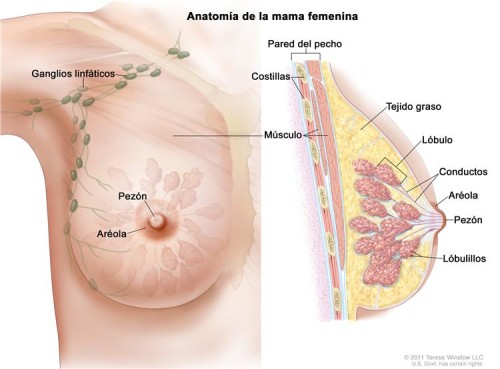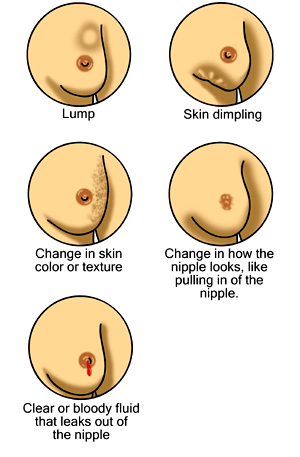 Breast Cancer is cancer that develops from breast tissue. Signs of breast cancer may include a lump in the breast, a change in breast shape, dimpling of the skin, fluid coming from the nipple, or a red, scaly patch of skin. People with distant spread of the disease may also have swollen lymph nodes, bone pain, yellow skin and shortness of breath also.
Breast Cancer is cancer that develops from breast tissue. Signs of breast cancer may include a lump in the breast, a change in breast shape, dimpling of the skin, fluid coming from the nipple, or a red, scaly patch of skin. People with distant spread of the disease may also have swollen lymph nodes, bone pain, yellow skin and shortness of breath also.
Types of Breast Cancer:
- Ductal Carcinoma in Situ is non-invasive cancer where abnormal cells have been found in the lining of the breast milk duct. The unusual cells do not extend beyond the ducts that surround breast tissue. Ductal carcinoma in situ is very early cancer that is highly treatable, but if it is left untreated or undetected, it can spread into the surrounding breast tissue.
- Infiltrative Ductal Carcinoma- The abnormal cancer cells that start building in the milk ducts expand over the ducts into other parts of the breast tissue. Invasive cancer cells can also spread to other parts of the body. It is also sometimes called infiltrative ductal carcinoma.
- Triple Negative Breast Cancer- The latest, extensive research of triple-negative breast cancer disclose that tiny molecules called micro-RNA used to describe four subtypes of this violent malignancy.
Inflammatory Breast Cancer
 It is an aggressive and fast-growing breast cancer in which cancer cells infiltrate the skin and lymph vessels of the breast. It often produces no distinct tumor or lump that might felt and isolated within the breast. But when the lymph vessels become blocked by the breast cancer cells, symptoms begin to appear.
It is an aggressive and fast-growing breast cancer in which cancer cells infiltrate the skin and lymph vessels of the breast. It often produces no distinct tumor or lump that might felt and isolated within the breast. But when the lymph vessels become blocked by the breast cancer cells, symptoms begin to appear.
- Metastatic Breast Cancer is also categorized as Stage 4 breast cancer. Cancer has spread to other parts of the body. It usually includes the lungs, liver, bones or brain.
- Medullary Carcinoma accounts for 3-5% of all breast cancer types. The tumor generally shows up on a mammogram. And it does not always feel like a lump. At times, it feels like a spongy change of breast tissue.
- Tubular Carcinoma cells have a different tubular form when seen under a microscope. Generally found on a mammogram and is a collection of cells that can feel like a wet area of breast tissue rather than a lump. Usually, this type of breast cancer is found in women aged 50 and above and also responds well to hormone therapy.
- Mucinous Carcinoma represents approximately 1% to 2% of all breast cancers. The main differentiating features include mucus production and poorly defined cells. It also has a favorable prognosis in most cases.
- Mammary Paget Disease- This state is an unusual type of cancer damaging the skin of the nipple and usually the areola. The areola is the darker circle of skin around the nipple. A large number of people with Paget disease observed with the nipple that also has more than one tumor inside the same breast; either invasive breast cancer (1–3) or ductal carcinoma in situ. Paget disease is frequently misdiagnosed at first because the first noticeable symptoms can easily be confused with more common skin conditions affecting the nipple. Just like all breast cancers, the diagnosis for Paget disease based on a variety of factors. Those factors include the presence or absence of invasive cancer. And whether or not it has scattered to adjacent lymph nodes also.
Symptoms
- A transform in how the nipple or breast feels
- A change in the breast or nipple appearance
- Nipple discharge especially bloody discharge or clear discharge
- Breast cyst
- Breast Pain
Causes
- Increasing age
- A personal history of Breast Cancer
- A family history of breast cancer
- Inherited genes that increase cancer risk
- Radiation exposure
- Obesity
- Beginning your period at a younger age and beginning menopause at an older age
- Having your first child at an older age
- Postmenopausal hormone therapy
- Drinking Alcohol





